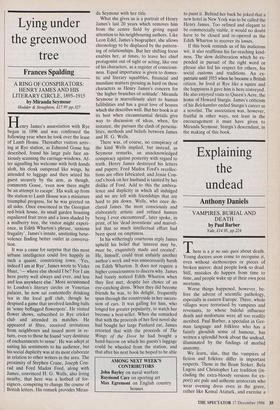Explaining the undead
Anthony Daniels
VAMPIRES, BURIAL AND DEATH by Paul Barber
Yale, £14.95, pp.224
There is a je ne sais quoi about death. Young doctors soon come to recognise it, even without stethoscopes or pieces of broken mirror: dead people look so dead. Still, mistakes do happen from time to time, and people wake up at their own post mortems.
Worse things happened, however, be- fore the advent of scientific pathology, especially in eastern Europe. There, whole villages were terrorised by vampires and revenants, to whose baleful influence death and misfortune were all too readily ascribed. Paul Barber, a specialist in Ger- man language and folklore who has a faintly ghoulish sense of humour, has written a splendid book about the undead, illuminated by the findings of morbid anatomy.
We learn, alas, that the vampires of fiction and folklore differ in important respects. Those in the Bram Stoker, Bela Lugosi and Christopher Lee tradition (in- cluding the extra-bloody versions for ex- port) are pale and asthenic aristocrats who wear evening dress even in the grave, rather like Kemal Ataturk, and exercise a fatal attraction for beautiful maidens pas- sing through Transylvania. They have glistening white fangs. Folkloric vampires, on the other hand, are distinctly plebeian in origin, have livid complexions and are revoltingly bloated. In general, they die unusual deaths: by suicide, murder or as the first victim of an epidemic (on whom all subsequent deaths are blamed).
Occasionally, however, fiction and folk- lore coincide. Vampires are thought to abhor strong smells like garlic; they cannot cross water; a stake through the heart is not good for them. Such a procedure is not invariably effective, though, which is why Dracula may plausibly be resurrected cine- matographically after the last and seeming- ly definitive nailing by Professor van Hels- ing of Amsterdam, and why epidemics continued to rage even after the responsi- ble vampire had been thoroughly staked. In folklore, cremation was the measure of last resort against vampirism but, as Mr Barber explains in a section of practical interest to intending murderers, the human body is peculiarly resistant to cremation without proper furnaces or abundant sources of energy, which the peasants of eastern Europe did not have.
How then did belief in vampirism arise? Mr Barber disposes briefly of the idea that certain forms of porphyria may have in- spired it: the proponents of this theory have paid too much attention to fiction and not enough to folklore. Mr Barber's theory is more plausible. Death, he says, was conceived as the cessation of all change, for change implied activity and activity implied will. But human bodies do change after death, in ways that were not systema- tically studied until the 19th century. When misfortune struck pre-scientific communi- ties, as it frequently did, the question asked was not 'How has this happened?' but 'Who caused this to happen?' It is not difficult to envisage, therefore, how nor- mal but misunderstood and alarming post mortern changes, such as bloody liquid around the swelling, dissolution of rigor mortis, and sloughing of the top layer of the skin to reveal a 'new' skin below, combined with an inveterate tendency to indulge in the fallacy of post hoc ergo propter hoc, led to a self-reinforcing ex- planatory system involving vampires and revenants.
Mr Barber explains many subsidiary phenomena that must have terrified deeply superstitious people who were prey to all classes of disaster. He describes how hands and even whole bodies might have appeared to rise through the earth in which they were buried (shallow graves, of course, were common during epidemics); and there are further useful hints for murderers planning to dispose of their victims under water. But the main value of this inost interesting book is to remind us how far we have come in our ability to explain the world and how this has released us from at least some terrors.



























































 Previous page
Previous page